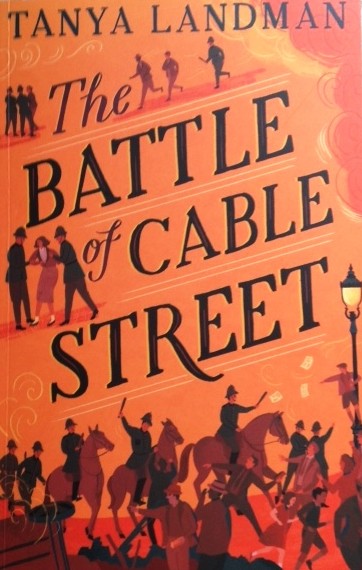Inspiring Young Readers
 posted on 25 May 2022
posted on 25 May 2022
The Battle of Cable Street by Tanya Landman
A new book from Tanya Landman is always something to look forward to and her latest offering, The Battle of Cable Street, for the ever excellent Barrington Stoke publishing house, is a real belter.
I love books that bring the ‘invisible’ or forgotten parts of working class history to life for a new generation of readers. I also admire the way Landman doesn’t make it an easy story – she herself points out at the beginning of the book just how inadequate simple stories about noble British opposition to Nazi fascism can be:
“There’s a lot of talk these days about the Second World War and how plucky little Britain stood up to Hitler all alone. People rave about the Blitz Spirit when bombs were being dropped on us night after night and we all kept calm and carried on. They say that Hitler’s rise to power in the 1930s was Germany’s problem, and that nothing like that could possibly happen over here.
They’re talking nonsense.”
To illustrate just how there were plenty of Britons who found themselves being drawn to the siren voices of fascism, Landman tells us the story of young Elsie, her family and her friends who live in the shockingly poor but diverse slum housing of Stepney in London - here Christians and Jews live side by side united by their common poverty. The real name of their building is the Paragon but all those who live in the flea and vermin-infested housing know it ironically as ‘Paradise’.
Elsie and her brother Mikey have a tight group of friends who play together and are ‘led’ by the older boy, Nathan Cohen who is charismatic and kind to the younger children. Poverty gives everyone plenty to contend with and they are all looking for role models or heroes and Nathan thinks his found his in the story of Kid Lewis – a local legend who made a fortune boxing, spent it all and was now living back in the neighbourhood. Here was an example that even in such poverty it was possible to grasp some glamour in life.
But politics is never far away in these febrile times and the rise of antisemitic fascist Oswald Mosley and his Blackshirts force their way into Elsie’s world and begin to tear apart her group of friends. When Kid Lewis also seems to take sides with the dreadful Moseley, Nathan knows he must drop his admiration of his hero and the time to take sides is coming.
When Moseley decides to hold a rally of the British Union of Fascists at Olympia in 1934, Mikey and Elsie decide it would be a good ruse to go there and heckle the speaker - but when they get there they realise that this is a movement that is getting out of control. Others, including Nathan, have had the same idea of getting in there to disrupt proceedings and, along with Elsie and Mikey, they find themselves on the wrong side of the fists and boots of the rally ‘organisers’.
Then the news comes that Moseley and his BUF plan to march through the streets of Stepney – the very streets where they live – and that their right to march will be enforced by the police. But the community who actually live there have other plans – they are going to prevent this march in any way possible.
What followed has become known as The Battle of Cable Street when a community came together to say no to anti-Semitism and no to fascism:
“…we said, No. No, Mr Moseley. You can’t. These are our streets. This is our home. What we say matters. And we say no.
And our NO was louder than all their yesses.
We stopped them.”
A final note from the author tells us what led her to write this engaging, exciting and thoughtful story and to remind us all that if this has happened once, unless we’re constantly strong and vigilant, it can happen again.
Published in June of this year, you can order your copy from your local independent bookshop or directly from the Barrington Stoke website.
Terry Potter
May 2022